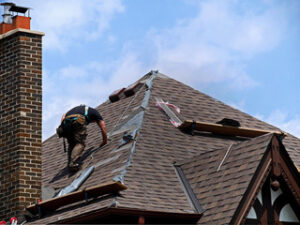Roof Repair NJ isn’t a one-size-fits-all project. It depends on several key factors.

First, a good inspection of your attic space is essential. Look for water stains, damp wood beams and other signs of leaks. Then, find the source. It could be a damaged pipe boot or flashing. Then, a new pipe boot and counter flashing will be installed.
Roof repairs vary in cost, depending on the specific problem and your roofing material. Asphalt shingle repairs are generally the least expensive, while slate and tile repair projects can be quite costly. If your roof is leaking and requires extensive work, replacing the entire roof may be more affordable in the long run.
The cost of your roof can also depend on the amount of damage and the extent of the work that is needed to repair it. If your roof is damaged from an especially harsh weather event, the costs will be much higher. This is because the damage will likely require a more intensive roof repair process, and the materials will be more expensive.
Some homeowners choose to perform their own roof repairs rather than pay for a professional service. If the damage is minor, such as a few missing shingles or a leak around a chimney or skylight, this may be a viable option. However, you should always consider your own ability to safely and effectively complete the task at hand before attempting a do-it-yourself repair project. For example, a roof repair project that involves replacing shingle tabs could be challenging to do without proper equipment like a hammer, pry bar, and the right roofing nails.
Your roof’s pitch and design will also play a role in the repair cost. Steep A-frames and other unique roof designs can be more difficult to work on and therefore more expensive. Additionally, if your roof has a lot of different levels, this can add to the overall labor costs.
Finally, the cost of your roof will depend on where you live. The prices will be higher in areas that experience extreme weather conditions, such as hail and high winds.
Roof repair costs are often less than the cost of a full roof replacement, making this a cost-effective option for homeowners with limited budgets. However, if the damage is widespread and the current roof is approaching its end of life, a full replacement will be more affordable in the long run. In addition, a new roof will often increase the resale value of your home.
Time
The time required for Roof Repair depends on a few things, including the extent of the damage. If your roof is old, deteriorated in appearance, or has suffered severe physical damage from a storm or other event, it may be more cost-effective to replace the entire roof rather than attempt to fix it with repairs.
However, if the problem is isolated to a small area of the roof or to one particular component of your roof, it may be more feasible to use repairs. This is especially true if you are planning to sell your home soon or if you want to avoid the expense of a complete roof replacement.
Roof repairs entail fixing pipes, flashing, and other components that may be leaking or causing other problems in an isolated area of the roof. This is much more time-consuming than replacing the whole roof and can be expensive in its own right. It is also important to consider the age of your roof and how long you plan to stay in your home when making this decision.
Safety
Working on roofs can be dangerous and requires a high level of safety. The most common cause of serious injuries is falls, which can be fatal if the worker is not using proper safety equipment. Workers completing roof repairs or inspections need to be trained in fall protection safety, including how to use and inspect all equipment involved with their work.
It is also important for workers to wear personal protective equipment, such as hard hats and eye protection. They should also use non-slip shoes and be prepared to be exposed to moisture, wind, and sun. Workers also need to be aware of the potential for tripping hazards, such as wires, power lines, and other overhead obstacles. Finally, the workers should be familiar with all workplace safety protocols, such as reporting hazards and following all necessary procedures.
Roofing repairs require that the workers climb up and down ladders, putting them at risk of falling off. Luckily, there are many ways to prevent this from happening. The first step is to ensure that the ladders are positioned properly. They should not be leaning against gutters, siding, or other structures. If they are, the ladders may tip over and cause serious injuries. Instead, the ladders should be placed on a stable surface and secured to prevent them from sliding down the roof.
Ladders must be secure and positioned at the correct angle, and workers should always walk on the rungs of the ladder to avoid shifting their weight and causing a fall. Workers should also be careful when carrying tools up and down the ladders. It is a good idea to have a safety harness attached to the roof frame, as well as a rope that can be used to lower workers safely.
Another way to reduce the chances of a serious fall is to clear away debris and keep the workspace clean. This will help reduce the likelihood of tripping and falling on sharp objects. It is also important to clean up any fallen shingles or other materials. In addition, it is essential to use aluminum or galvanized nails, as rust can weaken the roof and cause leaks.